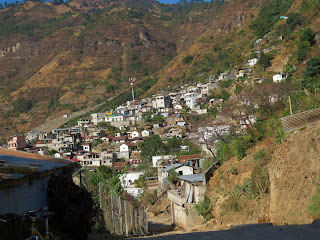After spending two weeks in Jardin de America Spanish school, re-learning Spanish grammar and building on my vocabulary, I've decided it's time to share with you some photos of the area - providing you with a larger picture of where I am working. Although I have not moved forward with the interviews, I have made many contacts with the fishermen in my travels around the lake and look forward to using my renewed Spanish skills this week!
 |
A beautiful anciana in Chichicastenango, Guatemala
Panajachel
is probably the most well-known town around Lake Atitlan.
It is usually the first place you arrive when visiting Lake Atitlan upon
leaving Guatemala City and all amenities
and activities of your liking are easily found. This is why it is also a
town filled with tourists coming and going, in awe of their surroundings
and at
first thinking 'I could stay here forever'. But after a bit of time has
come and gone and the people continue to barter with you day after day
the
realities of a tourist driven town begin to sink in. I have discovered
different routes through town, paths off the main street where I can
attempt to walk in peace. As much as I love to interact with the
diverse people coming and going, some days it is simply too much.
Still,
I feel happy
here, comfortable and grateful to be living and working among such a
vibrant culture. Nonetheless, the poverty and lingering remnants of
30-year civil war are present every day and unless you remind yourself
of your
purpose and that you are helping in way that is not directly dropping
quetzales
into the hands of the poor, it is easy to become discouraged and
somewhat
depressed. So here I present to you a photo essay, filled with color,
Guatemalan warmth, and a little bit of culture I have come to love, a
reminder of the beauty in this world. Coming not only from
Panajachel, but from the surrounding towns - the less traveled roads -
los
pueblos desconocidos.
Pictured below is a brief snapshot, as there is still so much to
explore. Although I will not venture too far from Lake Atitlan due to the
amount of work ahead of me, there are twelve surrounding towns, nine of which I
have yet to see.
|



















































No comments:
Post a Comment